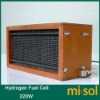- Solar Controllers[6]
- Solar Cells[6]
- Solar Energy Systems[6]
- Other Solar Energy Related Products[6]
- Solar Water Heater Parts[6]
- Valves[6]
- Electric Heater Parts[5]
- Stainless Steel Pipes[1]
- Sensors[1]
- Other Heat Insulation Materials[1]
- Inverters & Converters[6]
- Garden Lights[6]
- Temperature Instruments[3]
- Electrical Plugs & Sockets[2]
- Solar Chargers[3]
- Chargers[1]
- Heat Pump Water Heaters[6]
- Voltage Meters[1]
- Electricity Generation[2]
- Storage Batteries[6]
- Other Energy Related Products[6]
- Desk & Table Clocks[2]
- Other Consumer Electronics[2]
- Digital & Analog-Digital Clocks[1]
- Testing Equipment[1]
- Laser Rangefinders[1]
- Clamp Meters[1]
- Contact Person : Ms. Yang Kitty
- Company Name : Jiaxing Misol Import & Export Co., Ltd.
- Tel : 0086-573-82261037
- Fax : 0086-573-82509962
- Address : Zhejiang,Jiaxing,No.1-303, Central Garden
- Country/Region : China
- Zip : 314000
Related Product Searches:Hydrogen Fuel Cell 3000W,High Quality,Hydrogen Fuel Cell, Hydrogen Fuel Cell 3000W,EO-3000
What is Hydrogen Fuel Cell? A fuel cell is an electrochemical energy conversion device, similar to a battery in that it provides continuous DC power, which converts the chemical energy from a fuel directly into electricity and heat. When operated directly on hydrogen, the fuel cell produces energy with clean water as the only by-product. Unlike a battery, which is limited to the stored energy within, a fuel cell is capable of generating power as long as fuel is supplied. As such, the fuel cell system also has similarities to an internal combustion engine, except that it operates very efficiently at low temperatures and with minimal moving parts. Although hydrogen is the primary fuel source for fuel cells, the process of fuel reforming allows for the extraction of hydrogen from more widely available fuels such as natural gas and propane or any other hydrogen containing fuel.
How fuel cell works? Fuel cell are composed by the proton exchange membrane, catalyst layer, cathode (gas diffusion layer) , anode (gas diffusion layer) and collector plates. Proton exchange membrane and catalyst layer compose membrane electrode. Membrane electrode, cathode and anode gas diffusion layer compose MEA. Finally MEA and two collector plates compose a single cell. Gas(hydrogen and air) through the collector plate channel into both sides of the electrodes of proton exchange membrane. Through this channel hydrogen flow the anode coated with platinum catalyst, separated into hydrogen protons and hydrogen ions. Free electrons flows into the external circuit and produces an electric current; proton via electrolyte membrane move into the cathode. Oxygen in the air, the electrons and protons in the external circuit are reacted in the anode, producing pure water and releasing heat. Number of single cell formed fuel cell stack by splicing to provide the necessary power. Single cell `s open circuit voltage is about 1V, full load is about 0.6V. Single cell compose fuel cell stack in series to provide the necessary output voltage. Fuel cell`s output current was proportional with the effective area, therefore, fuel cell stack can via splicing geometrically to generate the required output voltage, current and power.
Features
Simpler Structure, Smaller Size and Lighter in Weights Thanks for the unique air cooled technology; the fuel cell system can be operated without humidification system for air and hydrogen as well as water-cooling system. For instance, weight of a 4 kW fuel cells system with PASH technology is just about 1/3 weight of conventional water-cooling and pre-humidification fuel cell system.
Higher Reliability Simplized structure of fuel cell system is the result of minimization of the quantity of accessories which loweres risk of system failure and increases the reliability of the whole system.
Competitive Cost Fewer accessories contributes a lot to the cost control of the whole fuel cell system.
Simpler Control System It is not necessary to control anything, except for electromagnetic valve and fan, when the fuel cell system works. The whole fuel cell system is easily applied into other products due to the simple control system.
Higher fuel efficiency Simplized Auxiliary system cosumes less power generated by stack and increases the fuel efficiency. Normally the auxilliary system only consumes 0.5%-3% of gross power generated by stack.
Better Environmental Adaptability and excellent performance of CCM The CCM has striking performance, 0.65V/800mA, without humidification. The CCM has excellent environmental adaptability. Our fuel cells can start up and work under environment temperature of -10°C as well as 20%-95% RH without any assistance of external power sources.
| | Products characters: | |
| - Light weight and small size; | ||
| - Low noise; | ||
| - Simple system and high reliability; | ||
| - Quick startup, good dynamic | ||
| - performance; | ||
| - Excellent environment adaptability; | ||
| - Simple control and communication policy. | ||
EO series of fuel cell system : PASH technology, can ensure fuel cells' more stable operation in atrocious weather and working environment.
EO 3000 fuel cell system is a highly integrated fuel cell system with compact design, who includes: fuel cell stack, fans, IC board and electromagnetive valve. 3000W is a suitable power for the mobile applications, for instance PC, motorcycle and backup power system.
| Parameter | ||
| Performance | Rated power | 3000W* |
| Rated voltage | 48V | |
| Rated current | 62.5A | |
| DC Voltage range | 45-78V | |
| Efficiency | ≥50% | |
| Fuel | Pure hydrogen | ≥99.95% |
| Pressure | 0.7-0.8bar | |
| Hydrogen consumption | 36L/min | |
| Oxidant/coolant | Air | |
| Pressure | Ambient Pressure | |
| Physical | Mass | 16.5 Kg |
| Characteristics | Length*width*height | 550mm*250mm*200mm |
| Operation | Environment temperature | -5-45°C |
| Condition | Relative Humidity | 10%-95% |
*Data achieved at the air temperature range from 15°C-30°C and the RH% from 30 - 90%
Hydrogen Fuel Cell 3000W








